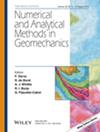Dynamic Behavior of GESC Groups in Sand Under Sinusoidal Loading: A Continuum‐Discrete Coupled Analysis
IF 3.4
2区 工程技术
Q2 ENGINEERING, GEOLOGICAL
International Journal for Numerical and Analytical Methods in Geomechanics
Pub Date : 2025-05-20
DOI:10.1002/nag.4000
引用次数: 0
Abstract
Geotextile‐encased stone columns (GESCs) for improving weak foundations commonly experience static and dynamic loads. However, the effectiveness of GESCs in resisting dynamic loading remains a concern. Three‐dimensional numerical models using a continuum‐discrete coupled method are developed to investigate the dynamic response of GESC groups in sand under sinusoidal loading. The models capture the dynamic variations in settlement (正弦荷载作用下砂土中GESC群的动力行为:连续-离散耦合分析
用于改善薄弱基础的土工布包裹石柱(GESCs)通常承受静态和动态载荷。然而,GESCs抗动载荷的有效性仍然是一个值得关注的问题。采用连续-离散耦合方法建立了三维数值模型,研究了正弦荷载作用下砂土中GESC群的动力响应。这些模型捕捉了沉降(δz)、侧向位移(δr)、孔隙度、配位数、接触力分布和径向应力系数()的动态变化。参数研究进一步检验了六个关键因素的影响。结果表明,与单一GESC相比,柱群效应使中心柱的δr降低了52.78%。GESCs表现为剪切变形和平移,δr随离团中心距离的增加而增大。最大δr的位置在x方向上随距离的增加而下降,z/D比值为0.83 ~ 2.5,而在y方向上保持稳定。高接触力在GESC底部积聚,最初达到峰值,然后随着时间的推移而下降。残余量小于2.0,明显低于被动土压力系数Kp。为设计目的,Kp高估了GESCs在动态载荷下的承载能力。GESC组对较低的加载频率更敏感,而较大的相对密度、土体强度或柱径可提高动力抗力。
本文章由计算机程序翻译,如有差异,请以英文原文为准。
求助全文
约1分钟内获得全文
求助全文
来源期刊
CiteScore
6.40
自引率
12.50%
发文量
160
审稿时长
9 months
期刊介绍:
The journal welcomes manuscripts that substantially contribute to the understanding of the complex mechanical behaviour of geomaterials (soils, rocks, concrete, ice, snow, and powders), through innovative experimental techniques, and/or through the development of novel numerical or hybrid experimental/numerical modelling concepts in geomechanics. Topics of interest include instabilities and localization, interface and surface phenomena, fracture and failure, multi-physics and other time-dependent phenomena, micromechanics and multi-scale methods, and inverse analysis and stochastic methods. Papers related to energy and environmental issues are particularly welcome. The illustration of the proposed methods and techniques to engineering problems is encouraged. However, manuscripts dealing with applications of existing methods, or proposing incremental improvements to existing methods – in particular marginal extensions of existing analytical solutions or numerical methods – will not be considered for review.

 求助内容:
求助内容: 应助结果提醒方式:
应助结果提醒方式:


